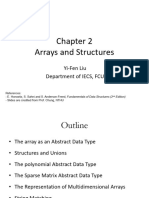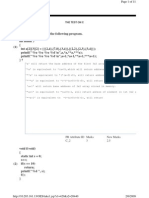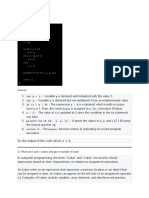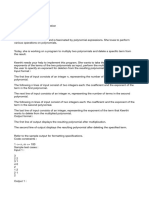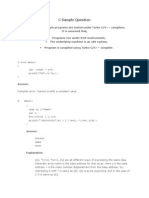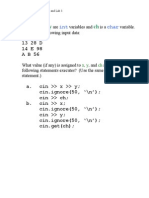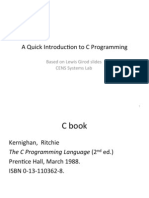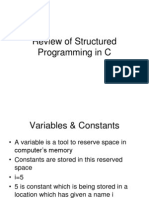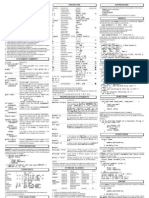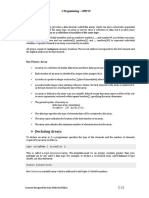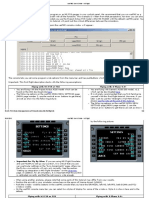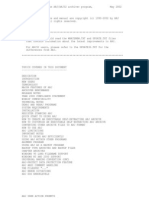SYSC 2006: Foundations of Imperative Programming
Lab 9 - Dynamic Memory Allocation
Background - A Polynomial Data Structure
A univariate polynomial; that is, a polynomial one variable with constant coefficients, can be
expressed as:
𝑎𝑛 𝑥 𝑛 +. . . +𝑎2 𝑥 2 + 𝑎1 𝑥 + 𝑎0
Each term in the polynomial consists of a variable x raised to an exponent and multiplied by a
coefficient. Here, the coefficients of the polynomial are the constant integer values an, an - 1, … a2,
a1, a0. 1
Here is the declaration for a C struct that represents a term in a polynomial:
typedef struct {
int coeff;
int exp;
} term_t;
Member coeff is the term's coefficient and member exp is its exponent.
Here is the declaration for a struct that represents polynomials that have at most MAX_TERMS terms:
#define MAX_TERMS 10
typedef struct {
term_t *terms[MAX_TERMS];
int num_terms;
} polynomial_t;
A polynomial_t structure has two members: term and num_terms. Notice the declaration of
terms:
term_t *terms[MAX_TERMS];
This means that terms is an array of MAX_TERMS elements, and these elements have type "pointer
to term_t"; in other words, each element in terms stores a pointer to a term_t struct.
Member num_terms keeps track of the number of terms in the polynomial; that is, the number of
pointers currently stored in the array.
1
Coefficients in polynomial terms may, in general, be real numbers; however, in order to simplify the
implementation and testing of some of the exercises, we will only consider polynomials in which the coefficients
are integers.
1
� SYSC 2006: Foundations of Imperative Programming
General Requirements
None of the functions you write should call calloc, realloc, or free. Only functions
make_term (Exercise 2) and make_polynomial (Exercise 4) are permitted to call malloc.
The function free is already called for you inside main.c
Your functions must not be recursive. Repeated actions must be implemented using C's while,
for or do-while loop structures.
None of the functions you write should perform console input; i.e., contain scanf statements.
Unless otherwise specified, none of your functions should produce console output; i.e., contain
printf statements.
You must format your C code so that it adheres to one of two commonly-used conventions for
indenting blocks of code and placing braces (K&R style or BSD/Allman style). Instructions were
given in the VS Code installation instructions.
Finish each exercise (i.e., write the function and verify that it passes all its tests) before you move
on to the next one. Do not leave testing until after you have written all the functions.
Getting Started
Step 1: Depending on your operating system, download (lab9_win.zip or lab9_mac.zip) the
starting code from Brightspace and extract the zipped file.
Step 2: Open the unzipped folder and double-click on the workspace file. You are now ready to
start working in your lab.
Step 3: lab9_xxx folder contains the following files:
● polynomial.c contains incomplete definitions of several functions that you have to design
and code.
● polynomial.h contains the declarations of the term_t and polynomial_t structs, as well
as the declarations (function prototypes) for the functions you will implement. Do not
modify polynomial.h.
● main.c and sput.h implement a test harness (functions that will test your code, and a main
function that calls these test functions). Do not modify main or any of the test functions.
Step 4: Run the project. It should build without any compilation or linking errors.
Step 5: Execute the project. For the functions where the test harness is provided (the functions in
main.c) several errors will be reported as it runs, which is what we would expect, because you
have not started working on the functions.
Step 6: Open polynomial.c in the editor. Do Exercises 1 through 6. Do not make any changes to
main.c, polynomial.h or sput.h. All the code you will write must be in polynomial.c
2
� SYSC 2006: Foundations of Imperative Programming
Exercise 1
File polynomial.c contains an incomplete definition of a function named print_term. Read the
documentation for this function and complete the definition. Notice that the function parameter is
a pointer to a term_t struct; in other words, the function argument is the address of a struct that
represents a polynomial term.
To keep things simple, a term is always printed using the format "ax^e"., even if the coefficient
is 1, negative, or the exponent is 0 or 1. Here is a table that lists, for several polynomial terms, the
coefficient and exponent that will be stored in the term_t structure, and how the polynomial
should appear when it is printed:
Term Coefficient Exponent Printed as
1 1 0 1x^0
x 1 1 1x^1
x2 1 2 1x^2
3 3 0 3x^0
3x 3 1 3x^1
3x2 3 2 3x^2
Test suite #1 exercises print_term, but it cannot verify that the information printed by the
function is correct. Instead, it displays what a correct implementation of print_term should print
(the expected output), followed by the actual output from your implementation of the function.
Use the console output to help you identify and correct any flaws. Verify that print_term passes
all the tests in test suite #1 before you start Exercise 2.
Exercise 2
File polynomial.c contains an incomplete definition of a function named make_term. Read the
documentation for this function.
Suppose main contains this statement:
term_t *term = make_term(2, 3);
Here is a C Tutor diagram that depicts memory after term is initialized with the pointer returned
by make_term:
3
� SYSC 2006: Foundations of Imperative Programming
Complete the function definition. Your implementation must call assert so that the program
terminates if:
● the term's coefficient is 0;
● malloc was unable to allocate memory for a term_t struct.
Use the console output to help you identify and correct any flaws. Verify that make_term passes
all the tests in test suite #2 before you start Exercise 3. (If make_term fails any tests, consider
using C Tutor to help you debug your code. Copy the declaration of term_t and your make_term
function into the C Tutor editor, and write a little main function that calls make_term. The image
displayed by C Tutor should look like the screen capture shown above.)
Exercise 3
File polynomial.c contains an incomplete definition of a function named eval_term. Read the
documentation for this function and complete the definition.
Use the console output to help you identify and correct any flaws. Verify that eval_term passes
all the tests in test suite #3 before you start Exercise 4.
Exercise 4
File polynomial.c contains an incomplete definition of a function named make_polynomial.
Read the documentation for this function.
Suppose main contains this statement:
polynomial_t *poly = make_polynomial();
Here is a C Tutor diagram that depicts memory after this statement is executed:
4
� SYSC 2006: Foundations of Imperative Programming
Complete the function definition. Your implementation must call assert so that the program
terminates if malloc was unable to allocate memory for a polynomial_t struct.
Use the console output to help you identify and correct any flaws. Verify that make_polynomial
passes all the tests in test suite #4 before you start Exercise 5. (If make_polynomial fails any
tests, consider using C Tutor to help you debug your code. Copy the declarations of term_t and
polynomial_t, and your make_term function, into the C Tutor editor, and write a little main
function that calls make_polynomial. The image displayed by C Tutor should look like the
screen capture shown above.)
Exercise 5
File polynomial.c contains an incomplete definition of a function named add_term. Read the
documentation for this function.
Suppose main contains these statements:
polynomial_t *poly = make_polynomial();
add_term(poly, make_term(2, 3));
add_term(poly, make_term(-1, 4));
Here is a C Tutor diagram that depicts memory after these statements are executed:
5
� SYSC 2006: Foundations of Imperative Programming
The first time add_term was called, it stored the pointer to the term_t struct created by
make_term(2, 3) in element 0 of array terms. The second time add_term was called, it stored
the pointer to the term_t struct created by make_term(-1, 4) in element 1 of array terms.
Variable poly now represents the polynomial -1x4 + 2x3.
Read the following notes, then complete the function definition. Your implementation must call
assert so that the program terminates if there is no room in the polynomial for additional terms.
Note 1: add_term can access element i in the terms array using this expression:
poly->terms[i]
This expression might appear complicated, so let us break it into pieces:
● Parameter poly is a pointer to a polynomial_t struct; for example, a pointer returned by
make_polynomial.
● Expression poly->terms is equivalent to (*poly).terms, so poly->terms selects
the array named terms in the struct pointed to by poly.
● Because terms is an array, individual elements are accessed using the [] operator. So,
poly->terms[i] is the element at position i in the array. This element stores a pointer
to a term_t struct.
Note 2: Your function should not make a copy of the struct pointed to by parameter term; instead,
it should just store the pointer in array terms;
Note 3: Do not worry about arranging the terms in increasing or decreasing order of exponents.
Each time add_term is called, just store the term_t * pointer in the next unused element in
array terms. This means that, if poly represents a polynomial of degree n, the first array element
6
� SYSC 2006: Foundations of Imperative Programming
(poly->terms[0]) does not necessarily point to the term with the highest power (n) (See the
memory diagram on the previous page.)
For example, we could reverse the order of the two calls to add_term:
polynomial_t *poly = make_polynomial();
add_term(poly, make_term(-1, 4));
add_term(poly, make_term(2, 3));
In this case, the memory diagram would be different from the one shown earlier (poly-
>terms[0] would point to the highest-order term), but poly would represent the same
polynomial: -1x4 + 2x3.
Use the console output to help you identify and correct any flaws. Verify that make_polynomial
passes all the tests in test suite #5 before you start Exercise 6.
Exercise 6
File polynomial.c contains an incomplete definition of a function named eval_polynomial.
Read the documentation for this function and complete the definition. Your implementation must
call assert so that the program terminates if the polynomial has 0 terms.
Use the console output to help you identify and correct any flaws. Verify that eval_polynomial
passes all the tests in test suite #6.
Wrap-up
Submit polynomial.c to Brightspace. Make sure it has been formatted to use K&R style or
BSD/Allman style, as explained in lab 3, Part 2, General Requirements.
Ensure that you submit the version of the file containing your solutions and not the unmodified
file that you downloaded from Brightspace!
Make sure that the code you submit can be opened, compiled, and run in the VS Code IDE.
Ensure that your code does not use any non-standard C extensions or libraries. If your code does
not compile and run, you will receive 0 for that submission.
We recommend that, after submitting source code files, you download the files from
Brightspace and verify that:
● the downloaded files have the correct filenames;
● the files can be opened and viewed in the IDE's editor;
● no syntax errors are reported when the code is compiled.
Once you have submitted your files, you must demo your work to the TAs for grades before
leaving your lab session.
Remember that your mark will be 0 if the TA did not check your work in the lab or your
submission was not on the system when the TA checked your work. No exceptions!
Note (applicable for all labs): It is your responsibility to keep track of the TA who graded
your work and to check that your grade is on Brightspace. If the grade is not on Brightspace
7
� SYSC 2006: Foundations of Imperative Programming
one day after you demo the work to the TA, contact the TA who graded your lab. Requests made
after the end of your next lab session will not be considered.
Solutions that are emailed to your instructor or a TA will not be graded, even if they are emailed
before the deadline.
Homework Exercise - Visualizing Program Execution
In the final exam, you will be expected to understand and draw diagrams that depict the execution
of short C programs that use dynamically allocated memory, using the same notation as C Tutor.
This exercise is intended to help you develop your code tracing/visualization skills.
1. Click on this link to open C Tutor.
2. Copy/paste your solutions to Exercises 2 through 6 into the C Tutor editor. You can
comment out the assert calls.
3. Write a short main function that exercises your functions.
4. Without using C Tutor, trace the execution of your program. Draw memory diagrams that
depict the program's activation frames just before each of your functions returns. Use the
same notation as C Tutor.
5. Use C Tutor to trace your program one statement at a time, stopping just before each
function returns. Compare your diagrams to the visualizations displayed by C Tutor. If C
Tutor complains that your program is too long, delete the comments above the function
definitions.
6. Do not submit your solutions for this exercise.





